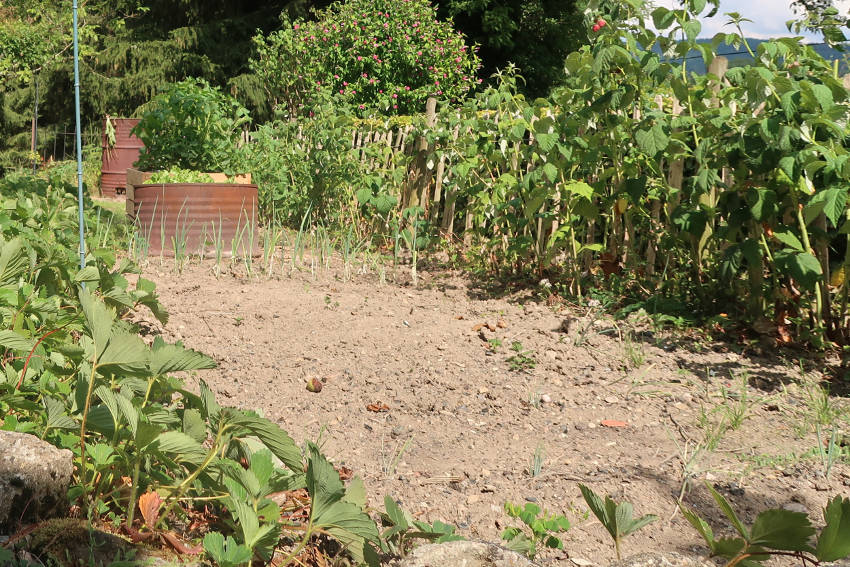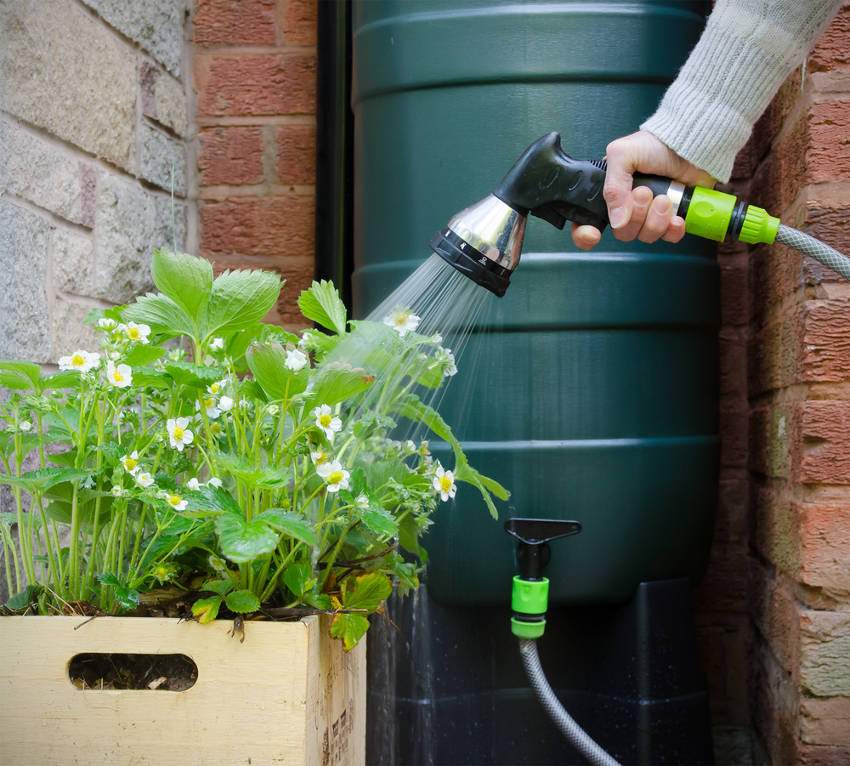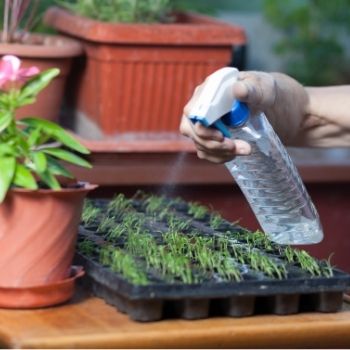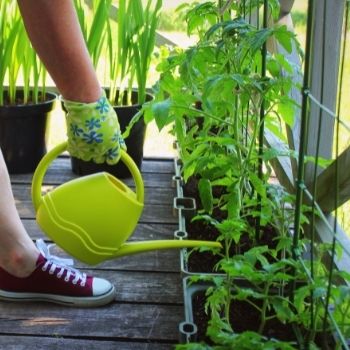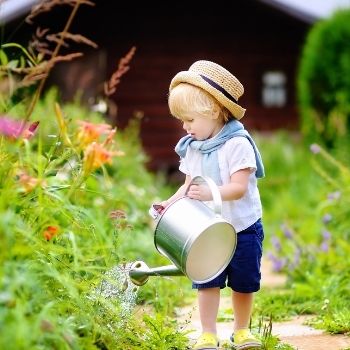Instant access to running water has blinded most people to its true value. It's so easy to turn on a garden sprinkler in the height of summer, even if you're living in a relatively wet area.
However, the serious environmental impacts of unnecessary water use tend to be unseen for urban dwellers. No matter how wet or dry your local climate, it makes sense to reduce water usage as much as possible.
There are three main approaches to doing this:
- Conserve water by using it carefully.
- Collect and re-use water to reduce the load on the public supply.
- Grow plants with low water needs to push your water usage even further down.
Here's what to do.
1) Conserving and Making the Most of Water
Improve Your Soil - Like so much else in gardening, water conservation starts with good earth. Digging plenty of organic matter into your soil helps it to retain moisture, while at the same time improving drainage to stop waterlogging. And that's not to mention the nutritional boost it'll give your plants.
Mulch the Soil to Lock in Moisture - You can help the soil retain even more moisture by applying a mulch, or a layer of material that protects the soil surface from excess heat and wind.
Almost any type of mulch from gravel to chipped bark will help retain moisture, but an easily degradable one such as straw will improve your soil at the same time for a double-whammy effect.
Consider Containers - Don't forget that containers need more regular watering than open soil, and the water usage soon mounts up. You can slow this down by mulching the compost surface, and by adding water-retaining crystals to the compost mix when you plant.
Is Watering Necessary? On open soil, check if watering is really necessary before turning on the hose. Rather than relying on testing surface dryness, slide a spade down into the earth, and see how moist the soil is at root level.
However, it's a good idea to water before a dry spell is forecast, even if the soil is still damp. Your plants will need plenty of reserve moisture to draw on, and if a sudden dry period dries the soil out completely, it'll take far more water to moisten it again.
Water Carefully and Sparingly - Rather than drenching the whole bed, water carefully around the base of each plant. Water slowly and with as little splashing and run-off as possible. This will mean as much of the water as possible soaks down to the roots, rather than evaporating on the surface.
An added benefit of careful watering is that it deprives surface weeds of moisture, helping to keep them in check.
When to Water - The ideal time to water is early in the morning. The day is still cool, and the water has time to moisten the soil deeply before evaporating.
If mornings aren't convenient, water in late afternoon once the full heat of the day has passed.
Avoid watering in late evening, as leaving moisture lingering overnight risks mould, rot, and damping-off disease.
2) Collecting and Re-Using Water
But no matter how sparingly you water, it's better to collect and re-use as much as possible rather than relying on the public supply.
Rain Tanks - A rain tank or water butt is an easy way to collect rainwater in times of plenty to use later. Run pipes from your home or greenhouse guttering to maximise the catchment area, and you'll be surprised how much you can collect from a good downpour.
And with a typical water butt storing over 300 litres of water, a single full tank is equivalent to around 20 minutes of full-power hose spraying.
Recycling Domestic Water (Grey Water) - But it's not just rainwater you can store. The typical household across the country uses around 350 litres of water a day, rising to 800 litres or more in dry areas.
A lot of this can be stored and re-used as 'grey water' in the garden. A low-tech way of doing this is to collect bath water in buckets and store it in a water butt for later watering.
However, it's an easy job for a plumber to set up diversion pipes from sinks, baths, showers, and washing machines, diverting the water automatically.
You may worry about using this water on your plants, especially edible ones, but with a little care it's perfectly safe. Household soaps and shampoos are normally harmless to plants in sensible quantities, and the typical small amounts of dirt and debris grey water contains won't worry plants at all.
However, stay clear of any stronger cleaners, disinfectant, bleach, dishwasher tabs, and other substances with a high chemical or salt content.
3) Water-Friendly Planting
Careful water management won't make much of an impact if you cultivate thirsty plants in a dry area. Luckily, there's a huge choice of drought-tolerant plants which will lower your watering needs without sacrificing beauty or fragrance.
Here are 29 of the best herbs and flowers to grow on a low-water budget.
7 Drought-Loving Herbs:
Rosemary - An evergreen bushy herb which is as ornamental as it is flavoursome. Rosemary prefers very well-drained soil, and is an excellent choice for hedges or borders where more thirsty plants would struggle.
Lavender - Lavender's scent on a hot breeze sums up summer for many people, as well as acting as a magnet for bees and butterflies. It hates waterlogged ground, so prepare your soil well and never overwater.
Oregano - Like most Mediterranean herbs, oregano is well-equipped to withstand dry spells. Its fragrant leaves can be used either fresh or dried in Italian, Greek, and many other cuisines.
Thyme - Thyme is another herb which thrives best in dry, stony ground. It's tough enough to withstand being trod on, so try planting it between paving stones to perfume the air as you walk by.
Mugwort - As a drought-resistant perennial shrub with grey-green foliage, mugwort provides visual interest and structure to even the driest garden.
Wormwood - A close relative of mugwort, wormwood is wind-resistant as well as drought-hardy. It can also grow up to a metre in height, making it a good choice for sheltering other more fragile herbs in an exposed patch.
Tansy - Tansy is tolerant of all conditions except waterlogged soil. It provides aromatic leaves from spring to late autumn, with yellow button flowers in late summer.
22 Drought-Hardy Flowers:
Snapdragon - Once established, snapdragon's deep root system means it can withstand dry periods. This tender perennial or annual provides months of blooms in shades from purple through to yellow.
Calendula - Providing stunning yellow or bright orange flowers, calendula is highly drought tolerant, although it grows best in cooler conditions.
Marigold - Once established, marigolds will continue to bloom throughout dry spells, providing cheerful yellow or orange double-headed flowers to boost any border.
Campanula - If your dry garden has a shady spot or two, campanula will feel perfectly at home. This self-seeding annual produces bell-shaped flowers which are a favourite of butterflies, and prospers best away from full sun.
Cosmos - Imagine a traditional cottage garden, and cosmos will surely spring to mind. Self-seeding and drought tolerant, cosmos will flower freely throughout the warmer months.
Dianthus - Also known as pinks, the many varieties of dianthus flourish in dry, sunny spots and provide some of the earliest spring blooms.
Sunflower - Sunflower is often grown as a commercial crop in drier areas. It's just as happy providing its iconic flower heads in a low-water garden, providing conditions don't become too arid.
Nigella - Nigella offers pretty blue flowers and fine, dill-like foliage. It grows best in a sunny spot, and only requires light watering during its short season.
Poppy - With their vivid red flowers and enthusiastic growth, poppies are ideal for a border. While they need fairly wet soil as youngsters, once established they are extremely drought hardy.
California Poppy - A close relative of the common poppy and sharing similar looks, California poppies thrive in dry, sandy conditions. Grow them in full sun to enjoy their vivid blooms.
Petunia - Petunias' striking violet or classic white blooms make them a mainstay of decorative borders, pots, and hanging baskets. Plant in full sun and water only lightly.
Zinnia - Zinnia's gold or orange flowers require plenty of sun and heat to fully bloom, arriving late in the season. Water young plants daily, but established plants are quite happy to go dry for a few days.
Salvia - The salvia family offers everything from blazing red blooms through to aromatic foliage for culinary and medicinal use. However, all salvias are tough enough to flourish in hot, dry conditions.
Vinca - The dark green foliage, bright but restrained flowers, and spreading habit make vinca a popular choice for borders. Frost-tender and drought tolerant, vinca loves hot summers.
Gypsophila - Ideal for rockeries and borders, this low, spreading perennial produces small but pretty flowers. Plant in well-drained soil, and keep watering to a minimum.
Yarrow - Yarrow produces clusters of white or pink flowers on tall stems. This sturdy plant is often grown to reduce soil erosion in drought-prone areas.
Gaillardia - With its sunburst flowers of up to 8cm in width, gaillardia is a favourite for cutting. Although it prefers moist soil, it can withstand periods of drought once established.
Brachycome - This Australian native produces daisy-like flowers in white, lavender, pink, or vivid blue. Brachycome prefers full sun and needs watering with a very light touch.
Four O'Clocks - Four O'Clocks gain their name from their habit of unfolding trumpet-shaped flowers in late afternoon to fill the evening air with scent. Equally happy in full sun or partial shade, four o'clocks are tolerant to both heat and drought.
Snow in Summer - Poetically named for their masses of low, tiny, white flowers, snow in summer makes for excellent moisture-retaining ground cover in hot, dry, gardens.
Cornflower - Cornflower's pretty blue flowers and narrow grey-green leaves are great for cutting and drying, and its tolerance for heat and drought means it needs little attention in the garden.
Portulaca - Portulaca's low growth with colourful double flowers makes it ideal for planting in rockeries and between paving stones, where the dry heat will cause it few problems.
Growing a low-water garden might seem a minor change in the larger picture, but gardeners are in a position to make a greater environmental impact than most people. It's only a small step, but if enough gardeners take it, the total difference could be huge.
